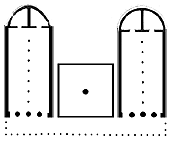|
Building complex comprising two main buildings, a square room and a stoa.
The edifices were erected south of the Temple of Zeus and date back to the
6th - 4th century BC.
Its establishment is closely related to the neighbouring cities of Elis
and Pisa, which controlled the sanctuary of Olympia. The two main
buildings had an oblong plan with apsidal endings and axial colonnades. They
dated from the 6th and 5th century BC, housed the meetings of the Olympic
representatives and the Hellanodikai, and were used as repositories of treasures.
The third, square building erected between the previous two, included an altar
and a statue of Zeus Orkios (of oaths), and was used for the
oath-taking ceremonies for the athletes,
at the opening of the Olympic Games.
Together with the ionic stoa that provided a long unified
facade for all three edifices, this building dates back to the 4th century BC.
Inscriptions give evidence of the existence of an "Ekklessia of Demos" (assembly of
the city, "damos plathion") not far off the Boule.
The building's unique placing in the sacred enclosure of Olympia, suggests a slightly
different function, compared to the Bouleuteria of other towns, which were mostly
administrative centers, usually placed in the Agora.
|

|


